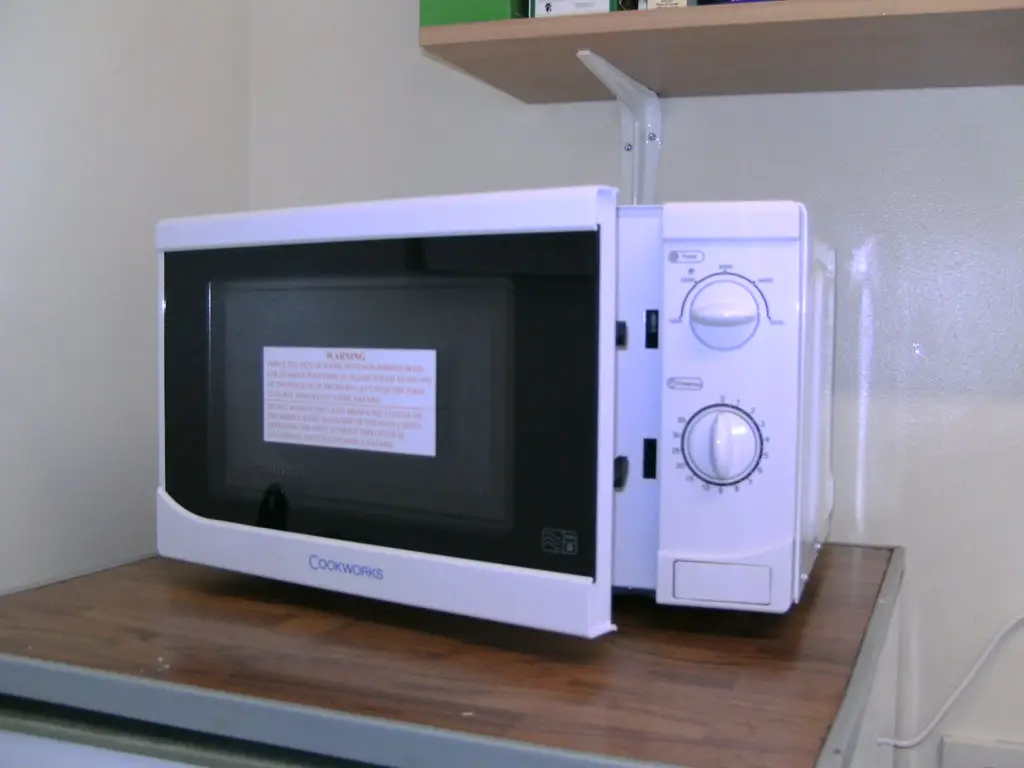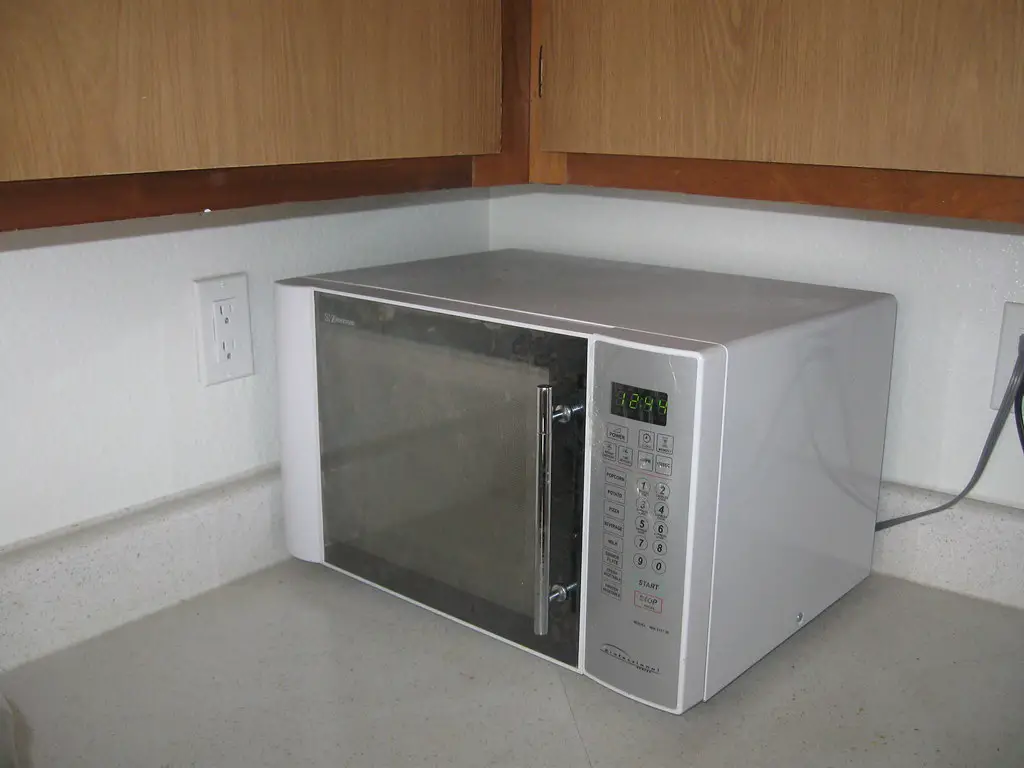Are you looking to get rid of an old microwave? Whether you are upgrading to something newer or just need to clear some clutter, knowing how to dispose of a microwave is a necessary skill.
To safely dispose of a microwave first, unplug it from the power source. Then, if this electronic gadget is still in working condition consider donating it to a local charity or thrift store.
If the microwave is no longer functional, contact your local solid waste management district to find out what options are available for disposal.
Depending on the location, you may be able to put it out for pickup with other large items or you may be able to drop it off at a local waste collection site.
What are Microwaves Made Of?

Microwaves are made of a variety of components, including:
1. Transformer – A transformer is a component that transfers electrical energy from the power supply to the other electrical components in the microwave.
2. The Magnetron – It is the component that produces the microwaves that are used to heat food.
3. A waveguide – The waveguide is like a metal conductor, ushering microwaves from the magnetron to the food chamber of the microwave so that dishes can be heated quickly and efficiently.
4. Cooling fan – The cooling fan helps to keep the components in the microwave cool and prevents them from overheating.
5. Cooking Case – It is the metal housing that encloses the food compartment and acts as a shield to prevent the device from escaping the oven.
6. The rotating disc/ Turntable – The rotating disc or turntable helps to evenly distribute the microwaves throughout the food, ensuring that it is heated evenly.
7. Control Panel – The control panel is part of the oven where the user can set the power level, time, and other settings.
8. Microwaves and Radiation – A microwave oven works by using electromagnetic radiation to heat food. It produces radiation in the form of microwaves, a type of electromagnetic radiation with a frequency between 300 MHz and 300 GHz, which corresponds to a wavelength of 1 millimeter to 1 meter.
The radiation is produced by an electron tube called a magnetron. When the magnetron is activated, it generates a rotating field of radiation that travel into the oven cavity and is absorbed by the food. This absorption causes the water molecules in the food to vibrate and heat up, thus cooking the food.
Reports from The University of Manchester state that a staggering 7.7 million tonnes of carbon dioxide equivalent are released into the air annually due to the use of microwaves in the EU.
9. Microwaves and Hazardous Waste – These units contain hazardous components such as capacitors, batteries, etc. When these components are disposed of improperly, they can leak dangerous toxins into the environment. Even if the oven is not leaking, the heavy metals and other toxins can still be released into the environment via incineration or landfilling.
In addition, the insulation from the oven can contain asbestos, another hazardous substance. For these reasons, microwaves are classified as hazardous waste and must be managed and disposed of in accordance with local, state, and federal regulations.
They also produce hazardous waste in the form of polychlorinated biphenyls (PCBs), which are potent environmental toxins. According to the United States Environmental Protection Agency, PCBs have been linked to a range of health problems, including cancer, immune system disruption, and hormone disruption.
How To Dispose Of A Microwave Safely?

Getting rid of a microwave isn’t just necessary for the sake of tidying up, it’s also essential for safety and environmental protection. To make sure you get rid of your oven the right way, follow any of these methods:
1. Unplug it: The first step to take when getting rid of a microwave is to unplug it from the wall. This will ensure that you are protected from any potential electrical shocks or harm.
2. Donate it: Once you have unplugged it then it’s time to dispose of it. One of the best ways to get rid of a microwave safely is to donate it. There may be local charities or non-profit organizations that accept donations of gently used appliances. You can also use online sites like Freecycle or Craigslist to find someone who might be able to use it.
3. Sell it: If you don’t have a charity in mind, you can always sell it. Try posting it on a classifieds website, or put up a sign in your local area. You can also use a platform like eBay to list the item for sale.
4. Take it to an Electronic Recycling Center: If you live in an area with an Electronic Recycling Center, you can take your microwave there to be safely disposed of. These centers will be able to safely break down this item into its component parts and recycle them.
5. Bring it to an Electronic Retail Store: Some electronic retail stores, such as Best Buy or Fry’s Electronics, have trade-in programs or will accept used microwaves for recycling. Call ahead to make sure the store accepts microwaves.
6. Manufacturer Take-Back Programs: Many appliance companies provide take-back programs to responsibly recycle or dispose of your old microwave. To confirm if your microwave manufacturer is included, investigate their policy.
7. Local Garbage Collector: If all else fails, you can take your old microwave to your local garbage collector. Make sure you check with them first to make sure they accept microwaves and follow all safety precautions when transporting them to their facility.
Can you throw away the microwave?
Yes, you can throw away a microwave. It is important to take certain steps in order to do so safely and responsibly. First, you should unplug it from the wall outlet and remove any attached cords. Next, you should remove the cover of the microwave and take out any remaining parts that are inside, such as the glass turntable, the lightbulb, and the plastic or metal shielding.
Once all parts have been removed, you can place this electronic gadget into a trash bag or box and take it to a local recycling facility or garbage dump. Please keep in mind that you should never put these units in the regular trash, as they contain potentially hazardous materials such as lead, cadmium, and mercury as shown in this study done by Research Gate. In addition, these devices should not be placed in curbside recycling bins as they are too large and heavy to be recycled.
Is It Safe to Take Apart a Microwave?
Taking apart a microwave is safe, but it requires extreme caution. This high-voltage appliance should never be taken apart while still connected to a power source. A mistake like this could have dire consequences. Plus even after it has been unplugged, the capacitor can still store a lethal shock for months and must be discharged prior to any kind of disassembly. Furthermore, be sure to put on protective eyewear and gloves before starting the process.
Once you have taken these safety precautions, you can carefully unscrew the back panel and remove any screws that secure the door. Once the door is removed, you can begin to take out the fan, the waveguide, and other removable parts. Be careful with these parts and store them in a safe place. When reassembling the microwave, remember to reconnect any power sources and check the wiring for any loose connections.
By taking all of these safety precautions, you can safely take apart this electronic gadget. Doing so can help you troubleshoot any issues with the appliance and can be a great way to DIY repair any problems.
Why Should Microwaves Be Disposed Of Safely?
It is of the utmost importance to properly discard microwaves in order to safeguard both the environment and humankind. Let us take a look at a few of the reasons why these devices must be responsibly disposed of:
1. These units contain hazardous materials like mercury, lead, and polychlorinated biphenyls (PCBs) which are harmful to human health and the environment. Therefore, they should be disposed of safely to prevent these materials from entering the environment.
2. Microwaves, with their capacitors and transformers, can be like ticking time bombs. Even when the appliance is unplugged, a large electrical charge can remain, waiting to be released in a powerful shock. To avoid this hazard, always get rid of this device in a proper way.
3. According to the National Library of Medicine, Microwave oven is considered e-waste, so if they are not discarded of properly they can pollute landfills and contaminate the surrounding environment.
4. Many parts of this electronic item are made of plastic, which can take hundreds of years to decompose if it is just thrown in the landfill carelessly.
5. Failing to properly discard a microwave can be a recipe for disaster, as its combustible components can quickly turn into a blazing fire hazard.
FAQ
Why Not Accept Microwaves for Garbage Disposal?
Microwaves are not acceptable for garbage disposal because they contain hazardous materials such as lead, polychlorinated biphenyls (PCBs), mercury, and other toxins. Not only that, but their capacitors can cause electric shocks if damaged during disposal. Lastly, these appliances can take up a lot of space when thrown into landfills, causing potential leakage of hazardous materials into the ground and water table. Do your part and make sure to get rid of these units safely and responsibly.
Do Old Microwaves Leak Radiation?
Old microwaves cannot leak radiation if they are properly maintained. This is because all these appliances are shielded and designed to contain the radiation within the unit. The radiation is confined to the inside of the unit by a steel-walled cavity, and there is a metal mesh screen that prevents the radiation from escaping. However, Health Canada warned that if the oven’s door is damaged or if there is a large amount of dirt around the seal, the amount of leakage could increase. So it is essential to keep your oven door and seal clean and undamaged. As long as these safety features are working properly, there should be no risk of radiation leakage.
How Long Does A Microwave Last?
The average lifespan of a microwave is 6-7 years. The length of time your device will last depends on how often it is used and how well it is maintained. High-end models typically last longer than standard models, although all of these electronic gadgets eventually need to be replaced. Regular maintenance, such as wiping down the interior and checking the ventilation, can help extend the life of your appliance.
Final Verdict
The World Health Organization sounds the alarm that e-waste presents an extremely hazardous threat to health and safety, with microwave ovens also falling within this category.
Hence proper disposal of this product is an essential component of preserving a safe and healthy environment. Taking the right steps to ensure that your microwave is disposed of in an eco-friendly manner is not only beneficial to our planet, but also to you and your family.
By following the steps outlined in this article, you can ensure that this appliance is discarded properly, without causing any harm to the environment.
Thank you for reading!
My name is Ella Vicedomine and I’m the founder of this blog. The aim is to start this informational blog to guide people on how to dispose of waste things around in the house but in the right way.

